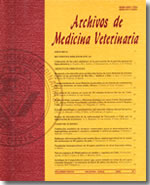Study of the embrionary development in sábalo (Prochilodus lineatus)
Main Article Content
Abstract
Currently, the storage of fish spermatozoa through cryopreservation is widely used. Although it is of common knowledge that the process of freezing / thawing generates DNA fragmentation of spermatozoa, the consequences of this process on embryonary development are unknown. There is great interest in developing methods for in vitro fertilization for the species Prochilodus lineatus using cryopreserved semen. In this paper we study the embryonic development of this fish, to lay the groundwork for the observation of abnormalities in the development of embryos derived from criopreserved spermatozoa. The eggs produced by this species are translucent and have a large perivitelline space, are of the telolecitic type, and presented meroblastic division during the early stages of development. Although the embrionary development of Prochilodus lineatus (Sábalo) took place in less time compared with Danio rerio (Zebrafish) the embryo goes through very similar stages. During the study it was possible to observe the periods of zygote, cleavage, blastula, gastrula, segmentation and hatching of the larvae of Sábalo. The different stages of development were successfully recorded, especially those after the transition of blastula media (TBM), when the embryo begins to transcribe its own genome.

